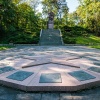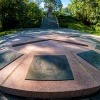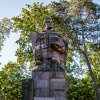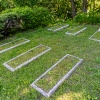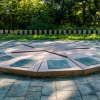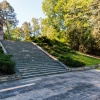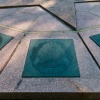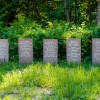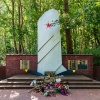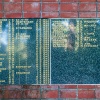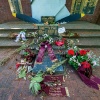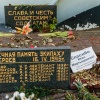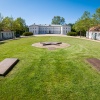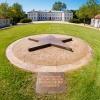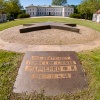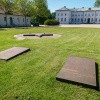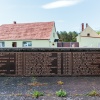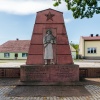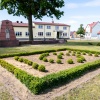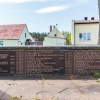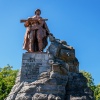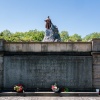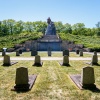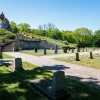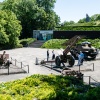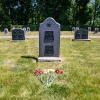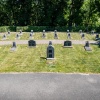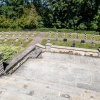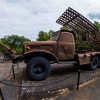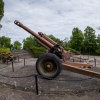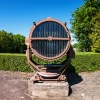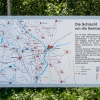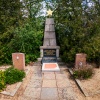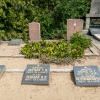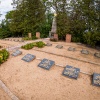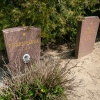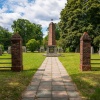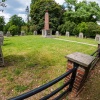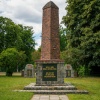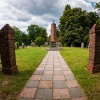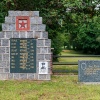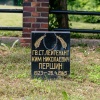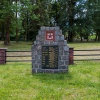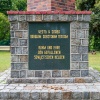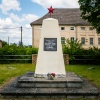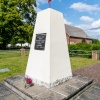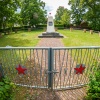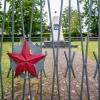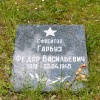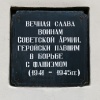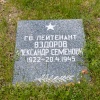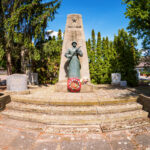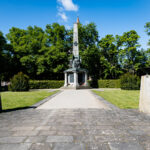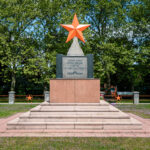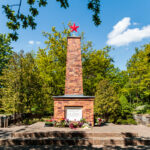75 Years – 75 Memorials – Stage 6: Seelow Heights and the Soviet memorials at the gate to Berlin
Stage 6 of the photo project “75 years – 75 memorials” leads me to the Seelow Heights Battle memorial, remembering the largest battle on German territory. Before I start this ~90 kilometres journey in Müncheberg, then ride through the hills to Buckow and Neuhardenberg, to give Platkow, Seelow, Alt Mahlisch, Heinersdorf and Steinhöfel a visit, to end in Fürstenwalde (Spree).
Here is the 1st stage – 2nd stage – 3rd stage – 4th stage – 5th stage – 6th stage – 7th stage of this photo project
Stone-aged stone roads massage my bum
If you ever wanted to know what the wooden axle of a medieval ox cart feels like, then you only have to cycle from Alt Mahlisch to Heinersdorf. Shortly after Lietzen the road seems to have survived thousands of years, that’s how old the cobblestone pavement appears. It makes the saddle massaging itself into one’s bum and takes fertility under a drumfire of Zhukov dimension.
But let’s begin the story where I kick off a bike trip, that is pretty much reflecting the frontline between Soviet troops and Nazi Germany back in mid-April 1945; the frontline of Zhukov’s 1st Belarusian Front pushing towards Berlin. At the bottom line that is the area between Oder River and Müncheberg, the town where I start. The Müncheberg memorial is directly located on Karl-Marx-Straße, a busy road once being part of even busier B1 federal road before the bypass got constructed. The Müncheberg war grave site is last resting place to 239 fallen. Two elements visually dominate the place. On the one hand the big disc with emblems and huge Soviet star, on the other hand the large Red Army soldier concrete sculpture at the upper end.
I head to Buckow, the centre of Märkische Schweiz. The bike ride this morning is wonderfully quiet and goes through pure hilly nature. Buckow road know to torture with historical cobblestone pavement as well. I wouldn’t be surprised if shock absorber consumption per capita here is the federal upper limit. Arrived at Lindenstraße, I am already standing in front of the local memorial.
With an upright standing silver wing and a propeller at its feet, the Buckow memorial primarily honours and reminds the Red Army air force. It is small but fine and last resting place for 146 fallen, the majority died in May 1945, literally in the last days of the war.
Memory card shock moments…
Photos and film are quickly in the bag when my breath stops. The memory card of my big Canon 1DX Mark II is full and old material cannot be deleted. Something’s wrong with the card. F**…! For a short moment I think about stopping for today, but then I decide to make a hard photo selection on the spot each time. Now I have to make the best out of 133 pictures space for the rest of the trip.
Before I go to Neuhardenberg, the routing sends me up and down the probably most stinging nettle-framed single trail far and wide. How wonderful… Burning nettles is supposed to help against rheumatism; in my case will be enough for two lives then. Neuhardenberg is quickly reached after 12 kilometres, but the Soviet memorial at Neuhardenberg is easy to miss. Not because of having eyes for picturesque Schinkel Church or the castle, but because of its very low rise.
Neuhardenberg, formerly known as Marxwalde, has a large Soviet star and four gravestones as memorial. It is centrally located on the castle forecourt, that is so called Schinkelplatz. The relatively small complex commemorates 156 fallen Red Army soldiers and is surrounded by a large lawn, being maintained with millimetre precision. The further route leads me via Platkow to Seelow. Pretty much in the middle between Neuhardenberg and Platkow deep inhaling is necessary as otherwise the biogas plant on the B167 will take your breath away, literally.
Seelow Heights – Where 14,000 guns turned soil into dust
Platkow village is so small that it has been merged with Gusow village. We Berliners call such tiny settlements “Kuhbläke” (=cow yelling). The Platkow Soviet memorial is located directly on B167 road and is a collective grave for 85 fallen. The gravestone dates correspond to the Battle of the Seelow Heights from April 16 to 18, 1945. Platkow – the village as well as its inhabitants – was right in the middle of things when 1st Belarusian Front with more than 1 million soldiers collided with German defence, that was Army Group Vistula.
The next stop on my bicycle tour is the large Seelower Höhen Memorial site. Its museum tells the story of the largest battle on German territory, that began with an infernal drumfire of 14,000 guns firing. Each gun, each grenade launcher could fire at least 3 to 4 times per minute. Zhukov’s cannonade lasted well half an hour. The battle, its bombs and grenades, turned the ground into a huge cloud of dust, as people tell having eye witnessed the battle from far away. The Seelow Heights war cemetery and its soldier statue remind of the memorial in Berlin-Treptow. That’s no surprise, as both statues emanate from sculptor Lev Kerbel.
The Seelow Heights are today the last resting place for 265 fallen Red Army soldiers. Below the gravesite is a very interesting museum showing a very informative documentary of this nightmarish battle. Of course military technology is also shown, such as a T-34 tank, a Katyusha rocket launcher – the famous Stalin’s organ pipes – as well as two artillery guns of calibre 76mm and 152mm. The Seelow Heights Memorial is definitely worth a day trip.
Cyclers from a different planet
I continue my journey to Alt Mahlisch. On the way I stop at the Kunstspeicher as my stomach claims food. Fresh zander filet with asparagus was a delighting break from cycling. When the Alt Mahlisch-bound dirt road spits me out, I crash three grannies’ the kaffeeklatch being held on the road. The lovely ladies look at me as if I just cycled in from a parallel universe, as if they’ve never seen a human before :-)
The Alt Mahlisch Soviet memorial is an obelisk and has individual grave sites as well as six mass graves. It is the final resting place for 300 Soviet soldiers. Then the bike ride goes to Heinersdorf, leading me exactly over the primeval cobblestone road I already mentioned in the beginning. At its end, I promise, you walk straddle-legged towards the Heinersdorf Soviet memorial. The memorial is fenced by brick columns and it is located in the immediate vicinity of the Heinersdorf lake. It is a war cemetery to honour 468 fallen Red Army soldiers and officers.
Before reaching Fürstenwalde and breaking the mark of 90 kilometres cycled, I go through Steinhöfel to visit the last Soviet memorial. Here in Steinhöfel, friends and fans of “fresh”, well, erm, country air will get their money’s worth. Even the noses of people suffering from a cold will have no chance to not notice the massive presence of biomass in abundance. My glasses almost fog up, but apparently the bush of stinging nettles next to the memorial entrance loves that. The maximum smell saturated air is probably already formidable fertilizer enough for it, as this guy grows lushly into the Brandenburg sky.
Here in Steinhöfel the Soviet memorial honours 76 fallen Red Army soldiers. Among them are also remains reburied from nearby other places. As I arrive in Fürstenwalde, the sky is completely cloud covered now. Fortunately, the regional express train RE1 saves me from further pedalling and takes me back home.
Here is the route as well as data of this tour on Komoot
